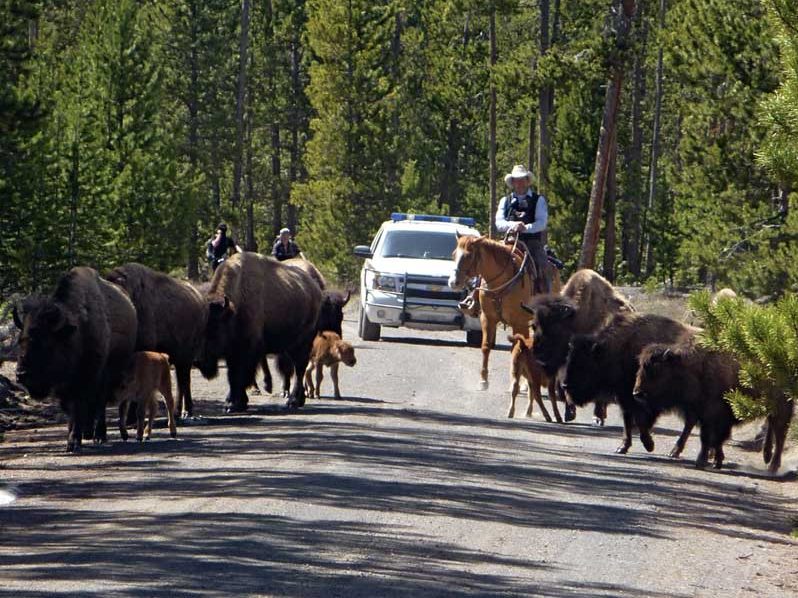Government hazers descended upon our soon-to-be national mammal this Monday, marking the season’s first forced removal operation west of Yellowstone National Park. Agents with the Montana Department of Livestock (DOL) and Fish, Wildlife & Parks (FWP) disturbed and chased forty-four buffalo with about twelve newborns from lands west of the South Fork of the Madison, in the Denny Creek area, a place buffalo love. Unfortunately, this is one of the last strongholds for the few seasonal private and public lands ranchers in the Hebgen Basin. However, no cattle occupy these lands until mid to late June. They are gone by October. Because of the short-term presence of cattle, these lands were excluded from the Governor’s year-round buffalo habitat designation. Ranchers like to use the excuse of brucellosis, but the real reason buffalo are chased out of this area is because the ranchers don’t want to share grass with the native buffalo.
BFC patrols were out in force documenting from multiple angles. The buffalo were chased across the South Fork of the Madison, then down a long power line trail which eventually led to the Madison Arm Road, where they hazed them further down the dusty gravel road, bullying them across the Madison River, and over to the bluffs that lead to Horse Butte, where buffalo are now safe from such abusive harassment. The buffalo were pushed at least ten miles, the tiny calves trying desperately to keep up with their moms and the rest of the herd. Our bike patrols followed, documenting everything, and tried to appeal to whatever compassion the hazers might have had to give these baby buffalo a rest and chance to nurse. When buffalo are left alone, newborn calves will take naps every five minutes, getting up to nurse for a few moments, maybe romp around for a bit, then quickly bed down for another nap. While the hazers went at a slower pace than usual, it was still too much for those little buffalo. Hazing, no matter the pace, is always abusive — that is the nature of it, to make wildlife uncomfortable or frightened enough to leave the place of their choosing to escape the danger.
The calves were growing more exhausted by the second. Their little legs were tiring, they were hungry, confused, and sticking close to their mothers. But the hazers wouldn’t relent. Nursing breaks and naps, which they sorely needed, were entirely out of the question. Surprisingly, a couple of hours into the haze, the hazers did stop for a moment. Did they actually hear our concerns? Did the buffalo reach a soft spot in their hearts? Of course not. The reason they stopped is because a couple of Yellowstone park rangers came through to observe. The rangers just drove through saying “nice and slow, that’s what we like to see,” and went on their way. As soon as they were out of sight, the cowboy tactics resumed. The rangers will likely report that the haze was “going well” but our footage will be able to show the truth of what really took place. It’s hard to know, but we hope that this first haze will also be the last of the season.
The buffalo hazed this week were part of the first large group to venture to this part of the basin this spring. In past years we have seen many more. In fact, there are very few buffalo in the entire Hebgen Basin right now, which is a source of concern. It’s also ironic, as this is the first time they are permitted to be here without the threat of hazing. In years past it was not uncommon to see between 400 and 600 buffalo, while currently there are barely 200. On a recent trip into the park we counted only forty buffalo between West Yellowstone and the Madison Junction, making us wonder if the hunt, slaughter, and winter kill had combined to severely impact the central herd, which migrates both north into the Gardiner Basin and west into the Hebgen Basin.
Fearing the worst, I called Yellowstone’s bison biologist who confirmed that management actions and winter kill had taken a heavy toll on the central herd, but he indicated that there were also some unusual weather patterns this year that may have contributed to so few buffalo being in the Hebgen Basin, changes that lead the buffalo to use the landscape differently than we normally see. Changing weather patterns are just a small piece of it, though. While natural forces are formidable enough, when combpounded with annual kills through indiscriminate boundary hunting and capture-for-slaughter, the population becomes increasingly vulnerable to collapse. Without understanding how their management decisions and climate change are combining to affect the health and viability of these herds, the agencies are threatening the future of America’s last wild bison.
Being on the ground, with the buffalo, observing them in their habitat, learning how and when they use the areas they choose to use, observing their behavior, family structures, and dynamics allows us to see the patterns and subtle changes that may hold significant meaning, and it puts BFC in an extremely unique position to be the strongest and most educated advocates for the country’s last wild buffalo.

